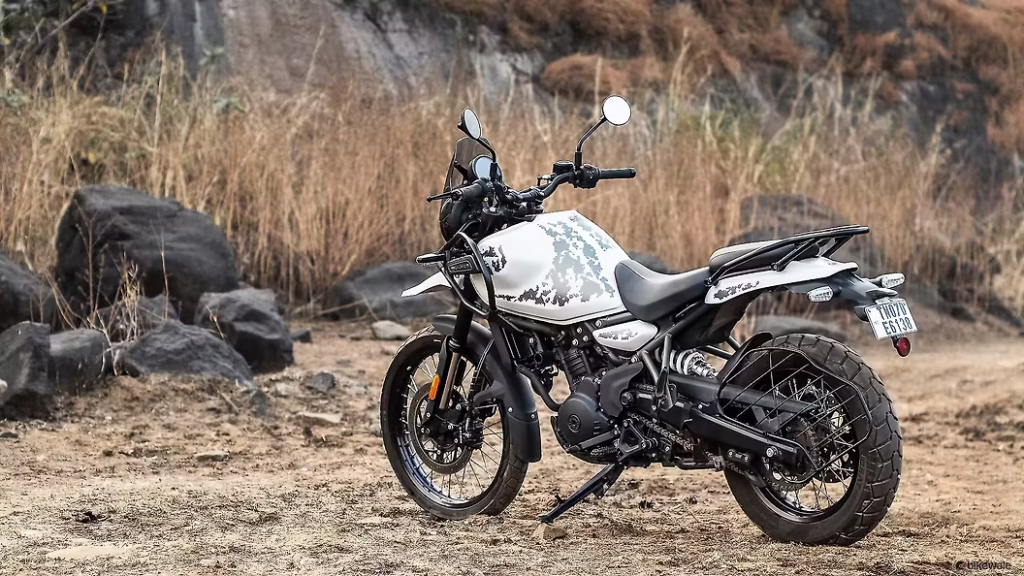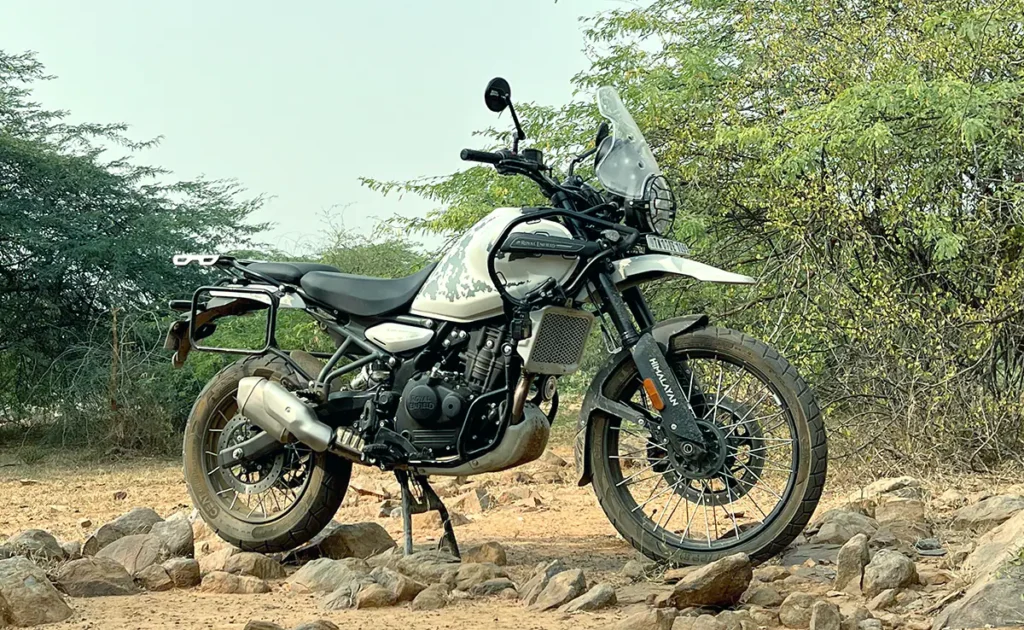The Royal Enfield Himalayan 450 is the next evolution of the Himalayan line. It keeps the spirit of its predecessor but brings a more modern engine, better suspension, electronics, and touring capability. In 2025, RE has made it a serious contender in the middle-capacity adventure segment. This review discusses styling, performance, comfort, features, fuel economy, pricing after GST 2.0, safety, ownership, pros and cons—written in simple, clear language and full complete paragraphs.
Quick Spec Table — Royal Enfield Himalayan 450 (2025 approx)
| Specification | Detail |
|---|---|
| Engine | 452 cc single-cylinder, liquid-cooled “Sherpa” motor |
| Power | ~40 PS |
| Torque | ~40 Nm (mid-range) |
| Transmission | 6-speed gearbox with slipper clutch |
| Frame | Reinforced perimeter frame |
| Suspension | Long-travel front forks; rear monoshock |
| Wheels | 21″ front, 17″ rear |
| Fuel tank | ~17 litres |
| Brakes | Single disc front and rear; switchable ABS |
| Electronics | Riding modes, traction control (on select trims), navigation, digital display |
| Mileage (real-world) | ~22–28 kmpl (varies with use) |
| Price (Ex-showroom 2025, post GST 2.0) | ₹3.05 lakh to ₹3.20 lakh approx |
| Ideal use | Adventure touring, mixed roads, occasional off-road |
Introduction: Why the Himalayan 450 matters
The Himalayan 450 aims to cross the line between pure adventure bikes and usable everyday motorcycles. Royal Enfield positions it as a bike that you can ride off road, take on highways, and not dread in town. Previously the Himalayan brand was known for its rugged simplicity. Now the 450 adds refinement and performance while keeping that off-road soul. Many riders had asked for more power, more suspension travel, and better electronics. The Himalayan 450 delivers on those fronts, making it relevant for India’s mixed road and trail conditions.
Design and presence

From a distance, the Himalayan 450 looks muscular and purposeful. It retains the tall stance, upright windscreen, round headlamp and long travel front end that define the Himalayan ethos. But the new model adds sharper lines, a wider tank, updated radiator shrouds, and a more sculpted tail section. The LED lighting gives it better night visibility and a premium look. Because the physical footprint is familiar yet improved, it feels rugged without being bulky. The result is a design that commands attention on highways, city streets, and even mountain passes.
Engine performance: the Sherpa 452 cc unit

Under the tank lies a single-cylinder, 452 cc “Sherpa” engine. It produces about 40 PS of power and torque in the midrange that’s usable off-road and on highways alike. Unlike older Himalayan models, this engine revs more freely, delivers smoother shifts, and reduces vibration. The six-speed gearbox with slipper clutch helps in downshifting on descents, while tall top gear aids highway cruising. The power delivery feels friendly at low speed yet lively when opened up. For Indian roads, this engine is balanced: not overly aggressive but capable when needed.
Also Read Bajaj Dominar 400 Review 2025 — India’s Premium Tourer with Smart Tech
Chassis, suspension and off-road capability
Royal Enfield upgraded the chassis with a stiffer frame and improved geometry. The front suspension uses long-travel forks, while the rear gets a modern monoshock with progressive damping. These changes make the bike more composed over broken roads and uneven trails. The 21-inch front and 17-inch rear wheels are ideal for dual-sport tyres. The Himalayan 450 handles loose gravel, dirt, and mild rock tracks with confidence thanks to good ground clearance and stable geometry. On asphalt, it feels planted and not overly twitchy, which is rare in this class.
Brakes, electronics and rider aids
One of the 2025 upgrades is the addition of switchable ABS — front only or dual-channel, helpful for off-road riding. The brakes offer good bite without being too aggressive. The Himalayan 450 also includes basic electronics such as a digital instrument cluster with navigation, smartphone integration, and turn-by-turn directions. Some variants feature riding modes and traction control, adapting engine response for road, rain or gravel use. These features give riders confidence across diverse surfaces.
Comfort and ergonomics for Indian riders
The Himalayan 450 offers a neutral, upright riding position that is comfortable over long distances. The handlebar height, seat width, and footpeg position are designed to reduce fatigue. The seat is well-cushioned and wide enough for longer days in the saddle. Wind protection is decent with the new windscreen—at highway speeds, it cuts wind blast effectively for many riders. The pillion seat is acceptable for shorter rides; for long tours, lighter pillion loads and good luggage ergonomics matter. The 17-litre fuel tank gives adequate range, making it better suited for long stretches between petrol stations.
Real-world mileage and range
Tests and rider reports place the Himalayan 450’s real-world mileage in the range of 22–28 km/l, depending on terrain, speed, and load. On steady highway cruising, the bike can stretch those numbers modestly. In mixed conditions—with trails, towns and highways—expect mid-20s as a realistic figure. With its tank capacity, that gives a practical riding range for touring across remote regions where fuel stations are sparse.
Pricing after GST 2.0 – what Indian buyers pay
In the wake of the GST 2.0 tax reforms, Royal Enfield adjusted prices across its line-up. For the Himalayan 450, the ex-showroom price in metro cities in 2025 ranges roughly between ₹3.05 lakh to ₹3.20 lakh depending on variant and accessories. Royal Enfield has announced that it will try to keep price increases minimal, absorbing part of the tax impact. Final on-road prices will vary by state, registration, insurance, and optional add-ons like luggage, crash guards or navigation kits.
Safety, reliability and service network
Royal Enfield supports the Himalayan line generously in India with wide service reach and parts availability. The new model’s safety features—ABS, traction control, riding modes—enhance confidence in adverse conditions. The build quality is robust; riders often praise how the Himalayan handles rough treatment. Given the brand’s service footprint, owners in urban and semi-rural areas should find maintenance doable and reasonably priced. For remote trails, know your nearest authorised workshop before heading out.
Competitors and how it compares
In 2025, the adventure and dual-sport segment has matured. Rivals include mid-capacity ADV bikes from global and Indian brands. Versys, NX300, KTM 390 Adventure, and others compete on power, features or off-road capability. The Himalayan 450’s strengths are its balance: good off-road hardware, touring ergonomics, and wide service support. It may not match high-end electronics of some rivals, but its value proposition, simplicity and proven lineage give it an edge, especially for Indian buyers who travel often on rough roads.
Pros and Cons
Pros
- Balanced engine performance for both trails and highways
- Upgraded suspension is more competent on broken roads
- Switchable ABS and electronics package improve safety
- Good touring ergonomics and fuel range
- Wide service support and ease of maintenance
Cons
- Third-party accessories may carry premium cost if OEM line is limited
- Pillion comfort is average for long days
- Mileage in trail use drops sharply
- It is not hyper-aggressive in power; buyers seeking outright performance may prefer rivals
FAQs — what Indian riders often ask
Q1: Is the Himalayan 450 good for high-altitude passes?
Yes. The engine and torque characteristics make it suitable for climbs and thin air. Riders report it performs reliably in mountain terrain.
Q2: What is the real fuel efficiency?
Real-world use shows 22–28 kmpl depending on load, terrain and riding style.
Q3: Will the ex-showroom price rise after GST changes?
Royal Enfield has stated they will absorb much of the tax burden. Thus the Himalayan 450’s ex-showroom pricing in metro cities now sits in the ₹3.05–3.20 lakh range, though final on-road costs depend on state and variant.
Q4: Can I ride the Himalayan 450 daily?
Yes. In town and mild commuting it is usable. The upright ergonomics, manageable weight and smooth engine make it decent for daily use, though long traffic will wear you. Its true strength is in highway and off-road work.
Q5: Which rivals should I compare it with before buying?
Look at the KTM 390 Adventure, Kawasaki Versys, Honda’s adventure offerings, and other middle-weight ADV bikes. Compare suspension, service network, spare availability, and comfort along with power.
Conclusion — is the Himalayan 450 right for you?
The Royal Enfield Himalayan 450 is a convincing upgrade in the adventure motorcycle segment. It carries the heritage of Himalayan touring but brings modern performance, electronics and comfort to match 2025 expectations. Its strength lies in its balanced package: capable in trails, comfortable on highways, and serviceable across India.
If you love riding over varied terrain, want a touring companion for off-beaten paths, and expect a bike that is upgradeable but not overly complicated, the Himalayan 450 is a strong contender. Before you decide, take a long test ride, try it on both highway and rough roads, and analyze your expected service path. In many ways, it is one of the best adventure bikes you can own in India today.


















